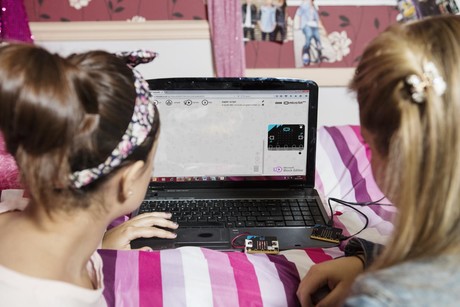How do you childproof the IoT?

Concerns about levels of computing literacy among young people, coupled with the likely demands of future economies, have led to the creation of programs aimed at encouraging more children to explore and program connected devices. But how do you prevent such an initiative from backfiring? Keeping our kids safe on the internet is one thing — how do we expand that to include the Internet of Things?
Schemes to help ensure future generations of digital innovators include the creation of the BBC micro:bit, a microcontroller with in-built sensors such as a compass and accelerometer, Bluetooth connectivity and pins that enable it to be connected to external sensors and other devices. The developers of the micro:bit took a considered approach to creating their device, purposefully restricting some functions — such as internet connectivity and radiocommunication — while strengthening security around others, such as Bluetooth pairing.
But many other devices are far less restricted, with many more likely to pop up in future. With this in mind, researchers from Lancaster University — including computer scientists involved in the development of the micro:bit operating software — are partnering with the National Society for the Prevention of Cruelty to Children (NSPCC), the Family Online Safety Institute (FOSI) and the Micro:bit Educational Foundation to learn more about how IoT devices could affect the privacy and security of young people.
The year-long project ‘Child Proofing the Internet of Things’ will see the researchers work with groups of children to find out the ways they would use IoT devices, as well as consulting with child protection experts. micro:bit devices will be a key focus of the project, with the educational tool helping to shed light on broader implications associated with children and all programmable IoT devices.
The research aims to:
- discover the likely privacy and security challenges arising from children using IoT devices;
- find out what design and programming considerations are needed to provide greater protection;
- determine what guidelines and advice is needed for children, their families and teachers for programming IoT devices.
“Because we want future generations to be computer literate and to have a better range of core programming skills, children are encouraged to interact with programmable devices,” said Lancaster University lecturer Dr Bran Knowles, principal investigator on the project.
“Many of these devices have great functionality that requires them to be connected to the internet. However, this could potentially cause concerns around the privacy and security of the children using these devices.
“By working closely with child protection experts, this research will help provide a much richer understanding of the potential implications that may arise with children and IoT.
“In addition, we will also explore how the micro:Bit, which was conceived as an educational tool, can be used to teach children how to engage safely with IoT devices.”
“This innovative project will help shape our understanding of how internet devices will be used by young people; knowledge we greatly need in today’s online world,” added Andy Burrows, NSPCC’s associate head of child safety online.
“As ever greater numbers of children start to use internet-connected toys and web-enabled household devices, it is crucial that we better understand the implications for child safety.
“This research will build our understanding of the privacy, security and safety implications for children, parents and policymakers, and we are pleased to be able to support it.”
Avoiding EMC issues: simple tests you can do yourself
This is a brief overview of EMC compliance with some practical tips on not getting caught out.
Electric dump valves help oil and gas company reduce emissions
Oil and gas company Laramie Energy deployed ASCO zero-emissions electric dump valves to comply...
Australia's largest electronics expo returns to Sydney
Electronex, the annual electronics design and assembly expo, will return to Sydney on 19–20...





